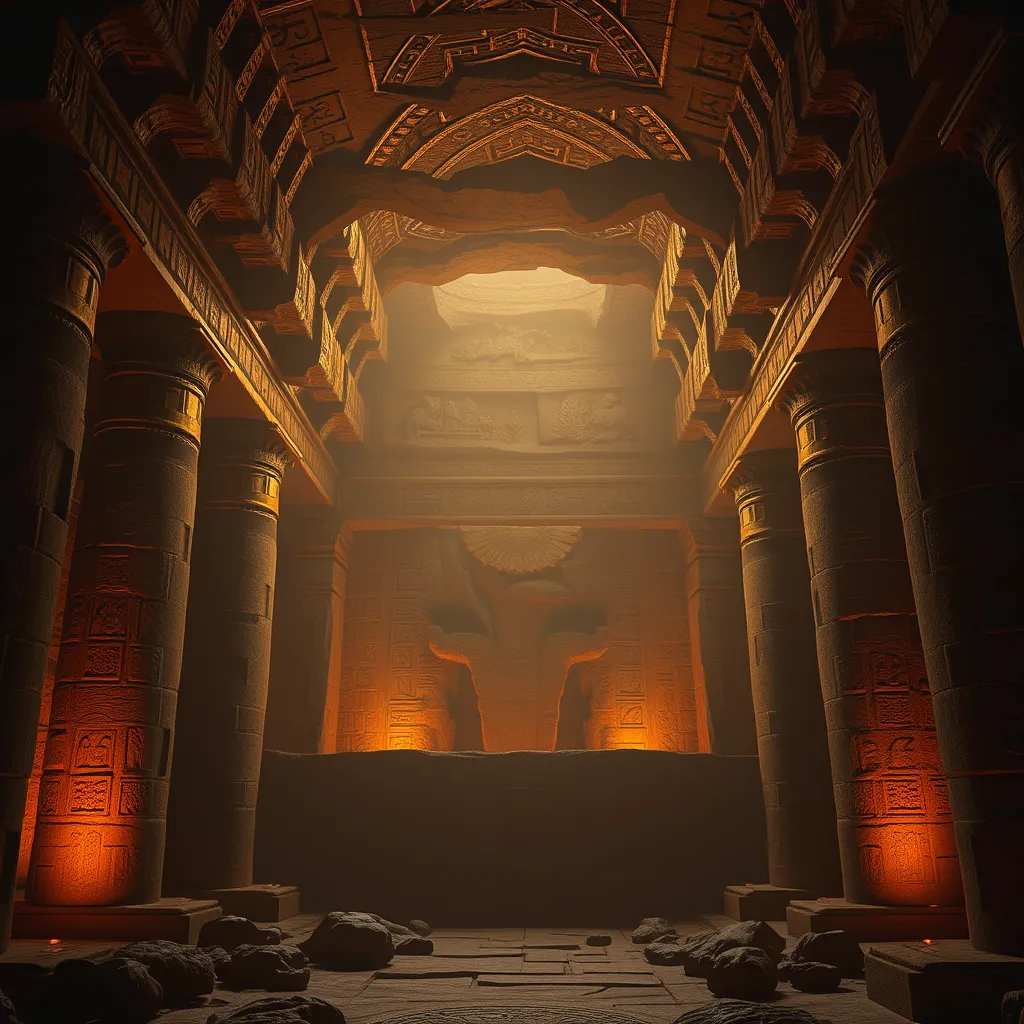The Duat: A Journey Through the Underworld
I. Introduction to the Duat
The Duat, a cornerstone of ancient Egyptian beliefs, represents the mystical realm of the afterlife. It is not merely a place of rest for the deceased but a complex and multifaceted expanse filled with trials, deities, and the essence of existence beyond death. The significance of the Duat is deeply rooted in the cultural, religious, and social fabric of ancient Egypt, shaping their understanding of life, death, and immortality.
In Egyptian mythology, the afterlife is portrayed as a continuation of life on Earth, with the Duat serving as both a journey and a destination. Souls embark on an arduous path through this realm, encountering various challenges and divine beings along the way. This article aims to explore the intricate nature of the Duat, elucidating its structure, deities, the soul’s journey, and the cultural practices surrounding it.
II. The Structure of the Duat
The Duat is often depicted as a vast and labyrinthine landscape, consisting of multiple realms and regions. Each area serves specific functions and embodies distinct symbolism that reflects the beliefs of ancient Egyptians regarding death and the afterlife.
Key locations within the Duat include:
- The Field of Reeds: A paradise resembling the Nile, where the souls of the righteous enjoy eternal peace.
- The Hall of Judgment: The crucial site where the heart of the deceased is weighed against the Feather of Ma’at.
- The Waters of Chaos: A treacherous expanse representing disorder, where souls must navigate trials before reaching their final destination.
Symbolism plays a vital role in the Duat’s structure. For instance, the journey through the underworld often symbolizes the cycle of death and rebirth, mirroring the natural cycles observed in the world above.
III. Deities of the Duat
The Duat is inhabited by a pantheon of deities, each with specific roles and responsibilities in guiding and judging souls. Major gods and goddesses include:
- Osiris: The god of the afterlife and resurrection, ruling over the Duat and providing judgment.
- Anubis: The jackal-headed god responsible for mummification and the protection of the dead.
- Ma’at: The goddess of truth and justice, whose feather is pivotal in the judgment process.
These deities are not only protectors of the dead but also embody the principles of order and balance essential for a successful passage through the Duat. Mythological stories often recount their interactions with souls, illustrating the challenges faced and the assistance provided during the journey.
IV. The Journey of the Soul
The journey of the soul begins at the moment of death. After the physical body ceases to function, the soul enters the Duat, embarking on a perilous journey through its various realms.
During this journey, souls encounter numerous trials, including:
- Confronting monstrous beings and obstacles.
- Navigating treacherous waters and dark passages.
- Facing the Weighing of the Heart, a pivotal moment in the journey.
Spells and rituals, often inscribed on tomb walls or within funerary texts, play an essential role in aiding souls. These incantations are believed to provide protection, guidance, and assistance in overcoming challenges encountered in the Duat.
V. The Weighing of the Heart
The Weighing of the Heart is one of the most iconic aspects of the Duat, representing the judgment process that determines the fate of the deceased. In this momentous event, the soul’s heart is weighed against the Feather of Ma’at, symbolizing truth and justice.
The process unfolds as follows:
- The deceased’s heart, representing their thoughts and deeds, is placed on one side of the scale.
- The Feather of Ma’at is placed on the other side.
- If the heart is lighter than or equal to the feather, the soul is deemed worthy and allowed to enter the Field of Reeds.
- If the heart is heavier, it is devoured by Ammit, the soul-eating monster, resulting in eternal oblivion.
This judgment process emphasizes the significance of moral conduct during one’s lifetime, underscoring the core values of ancient Egyptian society.
VI. The Role of Funerary Practices
Funerary practices were integral to ensuring a successful transition to the Duat. Mummification was vital in preserving the body for the afterlife, as the ancient Egyptians believed in the physical resurrection of the deceased.
Funerary texts, such as the Book of the Dead, were often included in burial practices. These texts contained spells, prayers, and guidance for navigating the Duat, providing essential knowledge for the soul’s journey.
Offerings placed in tombs were also significant, as they were believed to nourish the deceased in the afterlife. Common offerings included food, drink, and personal items, all intended to support the soul’s existence in the Duat.
VII. The Duat in Art and Literature
The Duat has been a prominent theme in ancient Egyptian art and literature. Artistic representations often depict the various realms, the gods of the Duat, and scenes from the judgment process, serving both decorative and educational purposes.
Literary sources, including inscriptions on tomb walls and papyri, illustrate the beliefs and practices associated with the Duat. These texts not only provide insight into ancient Egyptian culture but also reflect the significance of the afterlife in their daily lives.
The influence of the Duat extends beyond ancient Egypt, impacting later cultures and mythologies. The themes of judgment, the afterlife, and the moral implications of one’s actions resonate across various belief systems throughout history.
VIII. Conclusion
The Duat holds immense importance in the context of ancient Egyptian belief systems, representing a complex interplay between life, death, and the afterlife. The journey through the Duat encapsulates the values of truth, justice, and moral conduct, shaping the lives of individuals and society as a whole.
Reflecting on the legacy of the Duat, we find a rich tapestry of beliefs that continue to inform our understanding of life, death, and the mysteries that lie beyond. The ongoing fascination with the Duat in modern culture and scholarship underscores its timeless relevance and the enduring human quest for meaning in the face of mortality.




